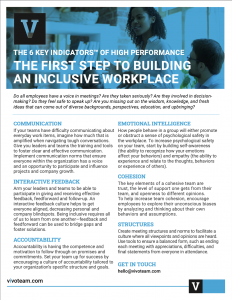Building a truly inclusive workplace may seem overwhelming, but it doesn’t have to be.
Start by thinking about these questions:
- Do all employees have a voice in meetings?
- Are all employees taken seriously?
- Are all employees involved in decision-making?
- Do all employees feel safe to speak up?
If you answered no to any of the above, that’s okay! Recognizing where improvements can be made is half the battle.
A great first step is to consider our six key indicators of high performance. Developing these skills does not only lead to the creation of highly-functioning teams and leaders—training in these areas also forms a solid foundation for inclusivity.
- Communication norms ensure everyone within the organization has a voice and an opportunity to participate in and influence projects—supporting company growth.
- Effectively identifying and managing your emotions while navigating the emotions of others (i.e., emotional intelligence) promotes psychological safety and supports inclusivity.
- Inclusivity requires all of us to be open and willing to learn from one another. Interactive feedback can be used to bridge gaps and foster solutions.
- Encourage a culture of accountability—follow through on promises. Such actions demonstrate a commitment to inclusion.
- Facilitate a culture where all viewpoints and opinions are heard. Implement meeting structures and norms; use tools to ensure a balanced form.
- To increase team cohesion, encourage employees to explore their unconscious biases. Analyze behaviors and assumptions which naturally builds trust, support, and receptivity among team members.
Find out more: DOWNLOAD (PDF)
Equip your teams and leaders with the skills necessary to build an inclusive workplace that drives collaboration and creativity.
.png?width=125&height=61&name=Logo%20-%20Vivo%20Team%20-%20White%20(2).png)


